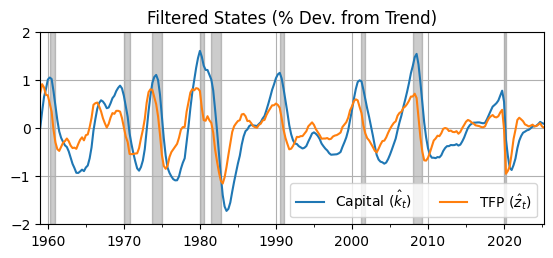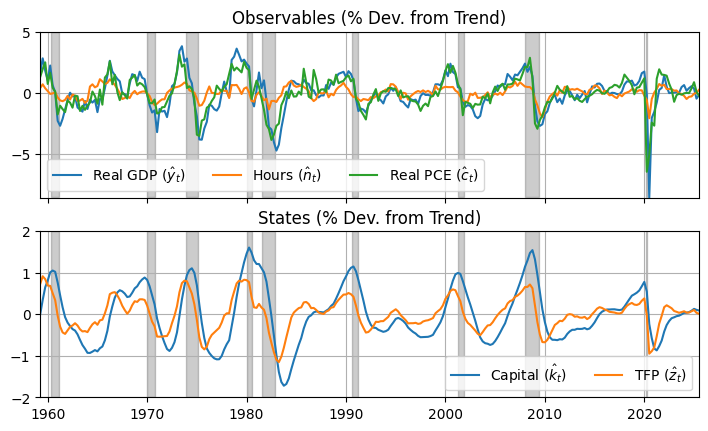RBC Model#
by Professor Throckmorton
for Time Series Econometrics
W&M ECON 408/PUBP 616
Slides
Summary#
Introduce a nonlinear theoretical model of business cycles.
Get the equilibrium conditions and linear the system of equations.
Solve the linear system, i.e., express (observable) endogenous variables as functions of (hidden) state variables.
Estimate the state vector with the Kalman filter.
The following example is a simplified exposition of Chad Fulton’s RBC example in Python here: https://www.chadfulton.com/topics/estimating_rbc.html
The Model#
A social planner chooses how much to consume, work, and invest, \(\{c_{t+j},n_{t+j},i_{t+j}\}_{j=0}^\infty\), to maximize present value lifetime utility
\[ E_t \sum_{j=0}^\infty \beta^j [\log(c_{t+j}) - \psi n_{t+j}] \]subject to:
resource constraint: \(y_t = c_t+i_t\)
capital accumulation: \(k_t = (1−\delta)k_{t-1}+i_t\)
production function: \(y_t = z_t k_{t-1}^\alpha n_t^{1 - \alpha}\)
Total factor productivity (TFP):
\(\log z_t = (1-\rho)\bar{z} + \rho \log z_{t-1} + \eta_t\) where \(\eta_t \sim N(0, \sigma^2)\)
\(E_t\) is an expectation operator conditional data through time \(t\), i.e., it’s a forecast because TFP is random/stochastic
Parameters#
This model has the following parameters
Parameter |
Description |
Parameter |
Description |
|---|---|---|---|
\(\beta\) |
Discount factor |
\(\rho\) |
TFP shock persistence |
\(\psi\) |
Marginal disutility of work |
\(\sigma^2\) |
TFP shock variance |
\(\delta\) |
Capital depreciation rate |
\(\alpha\) |
Capital-share of output |
Example parameterization
Parameter |
Value |
Parameter |
Value |
|---|---|---|---|
\(\beta = \) |
0.95 |
\(\rho = \) |
0.85 |
\(\psi = \) |
3 |
\(\sigma^2 = \) |
0.04 |
\(\delta = \) |
0.025 |
\(\alpha = \) |
0.36 |
The ultimate goal is to estimate (some of) these parameters.
Equilibrium#
The RBC model is a constrained optimization problem which can be written as a Lagrangian with the following first order conditions (i.e., equilibrium conditions).
In equilibrium, the marginal benefit (i.e., utility) of a unit of consumption today equals the marginal cost (i.e., lost future utility) forgoing the future return on a unit of investment:
\[ \frac{1}{c_t} = E_t \left \{\beta \frac{1}{c_{t+1}} \left [ r_{t+1} + (1 - \delta) \right ] \right \} \]where \(1/c_t\) is the marginal utility of consumption and \(r_t = \alpha y_t/k_{t-1}\) is the marginal product of capital.
In equilibrium, the marginal benefit (i.e., utility) of work equals the marginal cost (i.e., disutility) of work.
\[ \psi = \frac{1}{c_t} w_t \]where \(w_t = (1 - \alpha) y_t/n_t\) is the marginal product of work.
Including the constraints completes the nonlinear equilibrium system.
Linear System#
The linearized equilibrium system of equations is
\[\begin{gather*} - \gamma \hat{c}_t = - \gamma E_t\hat{c}_{t+1} + \beta rE_t\hat{r}_{t+1} \\ \hat{r}_t = \hat{y}_t-\hat{k}_{t-1}\\ \hat{c}_t = \hat{w}_t \\ \hat{w}_t = \hat{y}_t - \hat{n}_t\\ y \hat{y}_t = c\hat{c}_t + i\hat{i}_t \\ k\hat{k}_t = (1-\delta)k\hat{k}_{t-1} + i\hat{i}_t \\ \hat{y}_t = \hat{z}_t + \alpha\hat{k}_{t-1}+(1-\alpha)\hat{n}_t\\ \hat{z}_t = \rho \hat{z}_{t-1} + \sigma \eta_t \end{gather*}\]The state variables for this system are \((k_{t-1}, z_{t-1})\), i.e., the social planner needs to know those to make decisions at \(t\).
There are 8 variables, \(\{c,r,y,k,w,n,i,z\}\), which (importantly!) equals the number of equations.
This is a linear model with (rational) expectations/forecasts, i.e., the social planner forecasts with full understanding of the structure of the model, the initial conditions/state, \((k_{t-1}, z_{t-1})\), and the distribution of TFP.
A solution to the model expresses the endogenous variables \((y_t, c_t, i_t, n_t)\) as functions of the state variables \((k_{t-1}, z_{t-1})\).
We can obtain the solution with methods in Blanchard-Kahn (1980) or Chris Sims’ gensys.
The solution to the linear system is represented in state-space form.
Solution#
Observation equation(s):
State equation(s):
Given the above parameterization, the solution is
Parameter |
Value |
|---|---|
\(\phi_{ck}\) |
0.534 |
\(\phi_{cz}\) |
0.487 |
\(T_{kk}\) |
0.884 |
\(T_{kz}\) |
0.319 |
\(\alpha\) |
0.36 |
Business Cycle Data#
In the RBC model, \(\hat{x}_t \equiv 100\times(x_t/\bar{x} -1)\) where \(\bar{x}\) is the (constant) long-run equilibrium.
Q: What is the equivalent object in time series data with stochastic or time trends?
The Hodrick-Prescott (HP) filter is one (of many) mathematical tool(s) used to decompose a time series \(x_t\) into:
\(\tau_t\): A smooth trend component capturing both time and stochastic trends
\(c_t\): A cyclical component, i.e., the object of interest for business cycle economists
In other words, we can express the data as percent changes from a “long run equilbrium”, \(\hat{x}_t = 100(x_t/\tau_t - 1)\), i.e., percent deviations from trend.
In business cycle research, other popular choices are the band-pass filter and Hamilton filter.
James Hamilton wrote a critque of the HP filter, and then created “a better alternative,” which now has over 2000 citations as of Spring 2025.
The HP filter finds the trend \(\tau_t\) by solving a minimization problem:
\[ \min_{\tau_t} \sum_{t=1}^T (y_t - \tau_t)^2 + \lambda \sum_{t=2}^{T-1} \left[(\tau_{t+1} - \tau_t) - (\tau_t - \tau_{t-1})\right]^2 \]First term: \((y_t - \tau_t)^2\) makes the trend close to the actual data.
Second term: \(\left[(\tau_{t+1} - \tau_t) - (\tau_t - \tau_{t-1})\right]^2\) penalizes sharp changes in the slope of the trend, enforcing smoothness.
\(\lambda\) influences the smoothness of the resulting trend
Small \(\lambda\) → Trend follows the data closely (e.g., wiggly trend with “sharp” changes).
Large \(\lambda\) → Trend is very smooth (e.g., nearly a straight line).
Common Choices for \(\lambda\)
\(\lambda = 1600\) for quarterly data
\(\lambda = 14400\) for monthly data
\(\lambda = 100\) for annual data
Reading Data#
# Libraries
from fredapi import Fred
import pandas as pd
# Setup acccess to FRED
fred_api_key = pd.read_csv('fred_api_key.txt', header=None).iloc[0,0]
fred = Fred(api_key=fred_api_key)
# Series to get
series = ['GDP','PRS85006023','PCE','GDPDEF','USREC']
rename = ['gdp','hours','cons','price','rec']
# Get and append data to list
dl = []
for idx, string in enumerate(series):
var = fred.get_series(string).to_frame(name=rename[idx])
dl.append(var)
print(var.head(2)); print(var.tail(2))
gdp
1946-01-01 NaN
1946-04-01 NaN
gdp
2025-01-01 30042.113
2025-04-01 30485.729
hours
1947-01-01 117.931
1947-04-01 117.425
hours
2025-01-01 97.895
2025-04-01 98.038
cons
1959-01-01 306.1
1959-02-01 309.6
cons
2025-07-01 20982.7
2025-08-01 21111.9
price
1947-01-01 11.141
1947-04-01 11.299
price
2025-01-01 127.577
2025-04-01 128.248
rec
1854-12-01 1.0
1855-01-01 0.0
rec
2025-08-01 0.0
2025-09-01 0.0
# Concatenate data to create data frame (time-series table)
rawm = pd.concat(dl, axis=1).sort_index()
# Resample/reindex to quarterly frequency
raw = rawm.resample('QE').last().dropna()
# real GDP
raw['rgdp'] = raw['gdp']/raw['price']
# real Consumption
raw['rcons'] = raw['cons']/raw['price']
# Display dataframe
display(raw)
| gdp | hours | cons | price | rec | rgdp | rcons | |
|---|---|---|---|---|---|---|---|
| 1959-03-31 | 510.330 | 114.850 | 312.7 | 15.224 | 0.0 | 33.521414 | 20.539937 |
| 1959-06-30 | 522.653 | 115.194 | 318.2 | 15.248 | 0.0 | 34.276823 | 20.868311 |
| 1959-09-30 | 525.034 | 114.834 | 324.2 | 15.307 | 0.0 | 34.300255 | 21.179852 |
| 1959-12-31 | 528.600 | 114.570 | 322.9 | 15.367 | 0.0 | 34.398386 | 21.012559 |
| 1960-03-31 | 542.648 | 114.326 | 330.2 | 15.428 | 0.0 | 35.172932 | 21.402645 |
| ... | ... | ... | ... | ... | ... | ... | ... |
| 2024-06-30 | 29147.044 | 97.869 | 19844.5 | 125.167 | 0.0 | 232.865244 | 158.544185 |
| 2024-09-30 | 29511.664 | 97.803 | 20147.6 | 125.696 | 0.0 | 234.786023 | 160.288315 |
| 2024-12-31 | 29825.182 | 97.923 | 20514.3 | 126.450 | 0.0 | 235.865417 | 162.232503 |
| 2025-03-31 | 30042.113 | 97.895 | 20683.0 | 127.577 | 0.0 | 235.482203 | 162.121699 |
| 2025-06-30 | 30485.729 | 98.038 | 20868.4 | 128.248 | 0.0 | 237.709196 | 162.719107 |
266 rows × 7 columns
HP Filter#
The vector of observable endogenous variables is \([\hat y_t, \hat n_t, \hat c_t]\), where \(\hat{x}_t = 100(x_t/\tau_t - 1)\) and \(\tau_t\) is the smooth trend from the HP filter.
# Hodrick-Prescott filter
from statsmodels.tsa.filters.hp_filter import hpfilter
# Smothing parameter for quarterly data
lam = 1600
# Raw data to detrend
vars = ['rgdp','hours','rcons']
nvar = len(vars)
# Detrend raw data
data = pd.DataFrame()
for var in vars:
cycle, trend = hpfilter(raw[var],lam)
data[var] = 100*(raw[var]/trend - 1)
/opt/hostedtoolcache/Python/3.12.7/x64/lib/python3.12/site-packages/statsmodels/tsa/filters/hp_filter.py:100: SparseEfficiencyWarning: spsolve requires A be CSC or CSR matrix format
trend = spsolve(I+lamb*K.T.dot(K), x, use_umfpack=use_umfpack)
/opt/hostedtoolcache/Python/3.12.7/x64/lib/python3.12/site-packages/statsmodels/tsa/filters/hp_filter.py:100: SparseEfficiencyWarning: spsolve requires A be CSC or CSR matrix format
trend = spsolve(I+lamb*K.T.dot(K), x, use_umfpack=use_umfpack)
/opt/hostedtoolcache/Python/3.12.7/x64/lib/python3.12/site-packages/statsmodels/tsa/filters/hp_filter.py:100: SparseEfficiencyWarning: spsolve requires A be CSC or CSR matrix format
trend = spsolve(I+lamb*K.T.dot(K), x, use_umfpack=use_umfpack)
ax = data.plot(); ax.grid(); ax.set_title('Observables (% Dev. from Trend)')
ax.legend([r'Real GDP ($\hat y_t$)',r'Hours ($\hat n_t$)',r'Real PCE ($\hat c_t$)'],ncol=3);
fig = ax.get_figure(); fig.set_size_inches(6.5,2.5)
# Shade NBER recessions
usrec = rawm['3/31/1959':'12/31/2024']['rec']
ax.fill_between(usrec.index, -8.5, 5, where=usrec.values, color='k', alpha=0.2)
ax.autoscale(tight=True)

RBC Model in Python#
Set the parameters in the state space model, which represents the solution to the linearized RBC model.
# Define the state space model
# Parameters
phick = 0.534; phicz = 0.487
Tkk = 0.884; Tkz = 0.319
alpha = 0.36; rho = 0.85; sigma2 = 0.4;
Simplified Observation (Measurement) Equation: \(\mathbf{y}_t = \mathbf{\mathbf{Z}} \mathbf{x}_t + \boldsymbol{\boldsymbol{\varepsilon}}_t\) where \(\boldsymbol{\varepsilon}_t \sim N(0, \mathbf{H})\)
# Scientific computing
import numpy as np
# Observation equation
Z11 = 1 - (1-alpha)*phick/alpha
Z12 = 1/alpha - (1-alpha)*phicz/alpha
Z21 = 1 - phick/alpha
Z22 = (1-phicz)/alpha
Z31 = phick
Z32 = phicz
Z = np.array([[Z11,Z12],[Z21,Z22],[Z31,Z32]])
H = 1e-8*np.eye(nvar)
display(Z)
display(H)
array([[ 0.05066667, 1.912 ],
[-0.48333333, 1.425 ],
[ 0.534 , 0.487 ]])
array([[1.e-08, 0.e+00, 0.e+00],
[0.e+00, 1.e-08, 0.e+00],
[0.e+00, 0.e+00, 1.e-08]])
Simplified State (Transition) Equation: \(\mathbf{x}_t = \mathbf{F} \mathbf{x}_{t-1} + \boldsymbol{\boldsymbol{\eta}}_t\) where \(\boldsymbol{\eta}_t \sim N(0, \mathbf{Q})\)
# Transition equation
F = [[Tkk,Tkz],[0,rho]]
Q = [[0,0],[0,sigma2]]
display(F)
display(Q)
[[0.884, 0.319], [0, 0.85]]
[[0, 0], [0, 0.4]]
Kalman Filter#
from statsmodels.tsa.statespace.kalman_filter import KalmanFilter
# Initialize the Kalman filter
kf = KalmanFilter(k_endog=nvar, k_states=2)
kf.design = Z
kf.obs_cov = H
kf.transition = F
kf.state_cov = Q
# Initial state vector mean and covariance
kf.initialize_known(constant=np.zeros(2), stationary_cov=Q)
# Extract data from Dataframe as NumPy array
observations = np.array(data)
# Convert data to match the required type
observations = np.asarray(observations, order="C", dtype=np.float64)
# Bind the data to the KalmanFilter object
kf.bind(observations)
# Extract filtered state estimates
res = kf.filter()
filtered_state_means = res.filtered_state
filtered_state_covariances = res.filtered_state_cov
display(filtered_state_means.shape)
display(filtered_state_covariances.shape)
(2, 266)
(2, 2, 266)
Filtered (Estimated) States#
xhat = pd.DataFrame(filtered_state_means.T,index=data.index)
ax = xhat.plot(); ax.grid(); ax.set_title('Filtered States (% Dev. from Trend)')
fig = ax.get_figure(); fig.set_size_inches(6.5,2.5)
ax.legend([r'Capital ($\hat k_t$)',r'TFP ($\hat z_t$)'],ncol=2);
# Shade NBER recessions
ax.fill_between(usrec.index, -2, 2, where=usrec.values, color='k', alpha=0.2)
ax.autoscale(tight=True)

import matplotlib.pyplot as plt
fig, axs = plt.subplots(2,figsize=(6.5,4)); fig.set_size_inches(8.5,4.75)
axs[0].plot(data); axs[0].grid(); axs[0].set_title('Observables (% Dev. from Trend)')
axs[0].legend([r'Real GDP ($\hat y_t$)',r'Hours ($\hat n_t$)',r'Real PCE ($\hat c_t$)'],ncol=3);
axs[0].fill_between(usrec.index, -8.5, 5, where=usrec.values, color='k', alpha=0.2)
axs[1].plot(xhat); axs[1].grid(); axs[1].set_title('States (% Dev. from Trend)')
axs[1].legend([r'Capital ($\hat k_t$)',r'TFP ($\hat z_t$)'],ncol=2);
axs[1].fill_between(usrec.index, -2, 2, where=usrec.values, color='k', alpha=0.2)
axs[0].label_outer(); axs[0].autoscale(tight=True); axs[1].autoscale(tight=True)

Parameter Estimation#
loglike = res.llf
print(f"Log-likelihood: {loglike}")
Log-likelihood: -35903447159.552734
Kalman filter produces log likelihood for this parameterization
We could do a better job calibrating some parameters like the discount factor (\(\beta\)) and the labor preference parameter (\(\psi\))
Then we could search the parameter space for TFP process parameters, \(\{\rho,\sigma^2\}\), that maximize the log likelihood.
This model is very simple.
We could change the utility function to add a risk aversion parameter.
We could add investment adjustment costs and variable capital utilization.
We could add demand shocks from government spending or monetary policy.